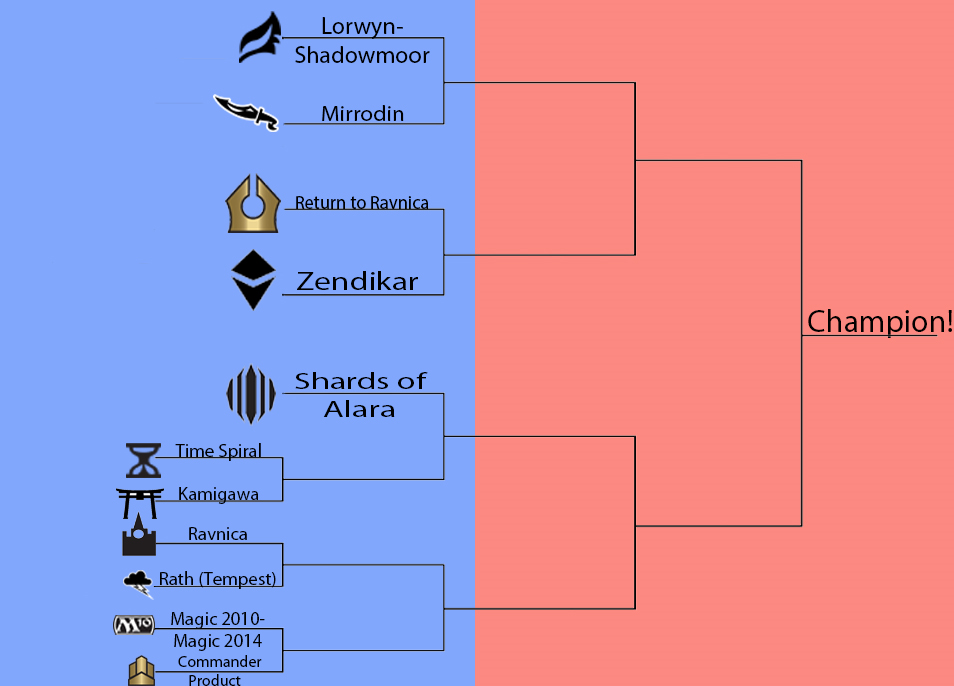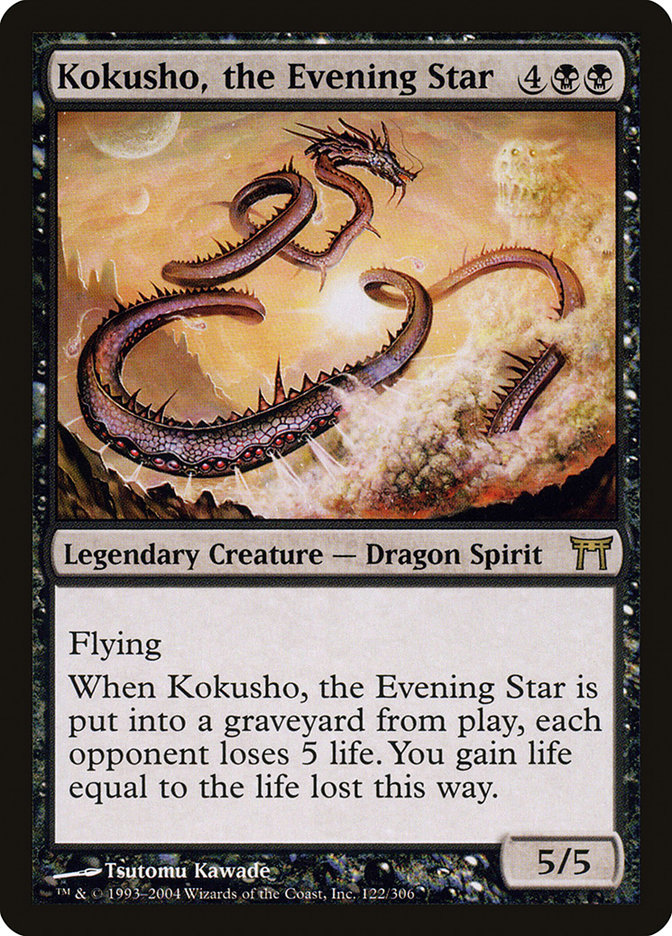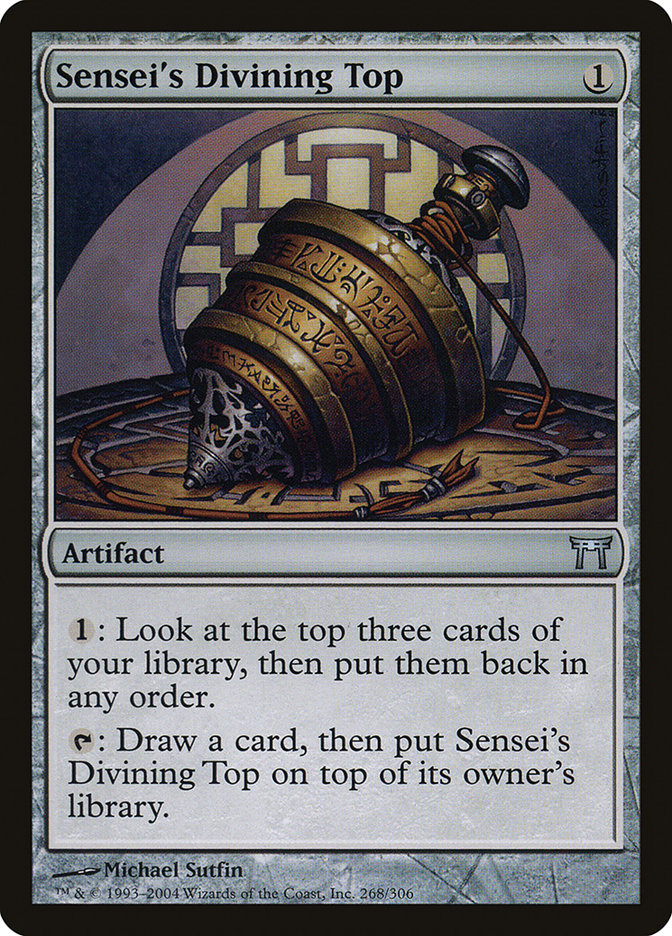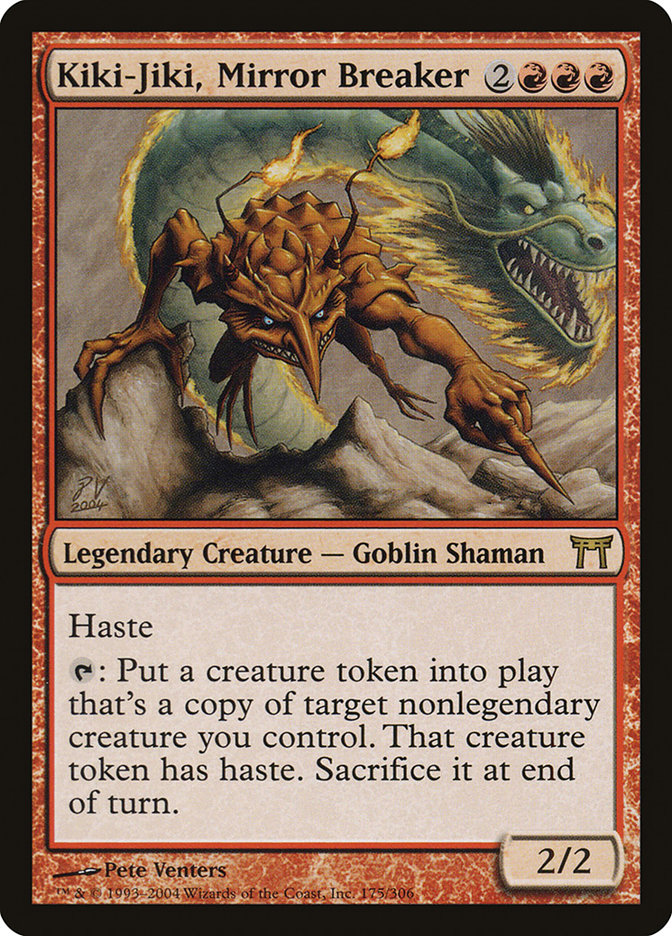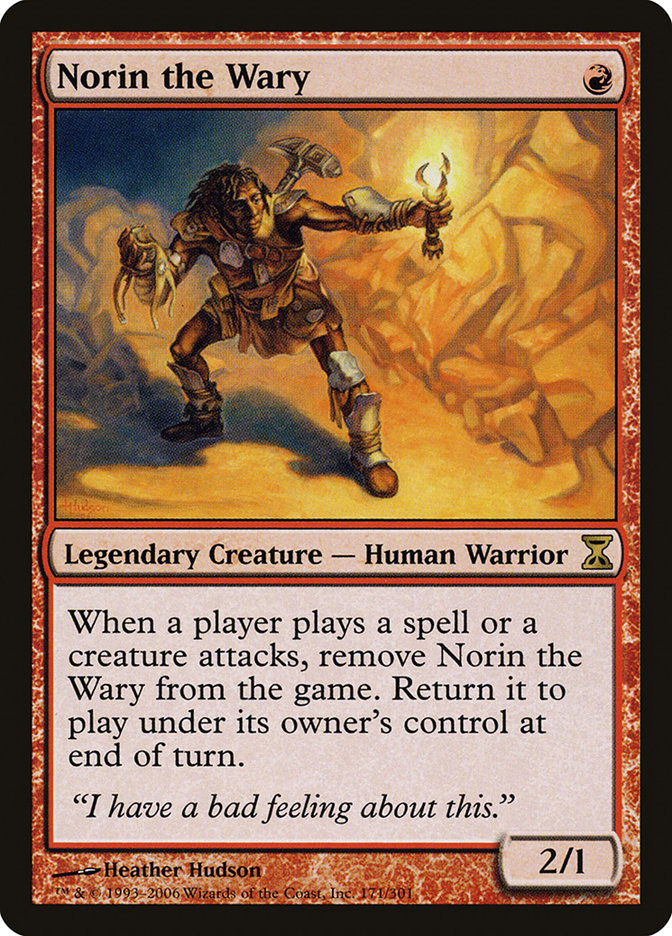Today’s battle pits the extremely deep Time Spiral Block against the Japanese-themed Kamigawa Block in a fight for Top 8 in our Commander-flavored competition!
Time Spiral block is a love letter to players who have invested themselves into the game for multiple years, with spells that are joking remembrances of older spells like Viscid Lemurs and some that sandwich mechanics from different blocks together to create new and interesting design space like Ichor Slick. Time Spiral block was also a horrible way to be introduced to the game, with incredibly complex cards for newer players; new mechanics like suspend that aren’t intuitive; and even three different frames for the cards in the block with the future-shifted borders, regular borders, and throwback borders on the Time Spiral sheet.
For the Commander format, these high-concept cards from Time Spiral block help plug holes that other sets couldn’t fill and allow decks to accomplish multiple goals with a single card. The only downside to Time Spiral block is the scatterbrained flavor straight out of a middle season of Doctor Who. The concept that Portals are opening and collapsing, spilling creatures and spells from all over the Multiverse onto Dominaria and forever altering the original planeswalker spark, wasn’t well communicated to the player base through the cards themselves.
Kamigawa block is based off of classical Japanese mythology and cast the player base amidst the great kami war as the spirit world clashed with the mortal denizens of Kamigawa in a fight to the finish. With the spirits of mountains and valleys coming to life, Kamigawa block succeeded in creating a unique world filled with awesome abilities like splice onto arcane and the flavorful soulshift that have been the focal points of casual decks for years. The only issue with Kamigawa block is how self-contained the block is from other Magic sets. Mechanics like soulshift and splice onto arcane barely work outside of Kamigawa block, and with so many cards within Kamigawa block relying on Spirits, arcane, or legendary permanents to be effective, they rarely see play outside of Kamigawa block decks.
In Commander, these parasitic mechanics force players to either play a deck dedicated to that strategy or stay away from it entirely. Thankfully Kamigawa brought more than just flavor to the battlefield, presenting some awesome staples for Commander to give it a great position in this contest.
Before we dive into this week’s article, let’s check out the bracket to see where the second round has taken us so far:
The Top 8 is looming on the horizon, with the winner of this round going on to fight against multicolored powerhouse Shards of Alara block! The blocks in this article will be compared in their contributions to the Commander format in the standard five categories: Staples, Commanders, Strategies, Flavor, and The Bad.
Staples
Five Notable Staples From Kamigawa Block
1) Sakura-Tribe Elder
2) Kodama’s Reach
3) Kokusho, the Evening Star
4) Sensei’s Divining Top
5) Ghostly Prison
Now that Kokusho, the Evening Star is unbanned in Commander, it can return to the battlefield and engulf the opponent’s life totals as it hops in and out of the graveyard. The triumphant return of Kokusho is galvanized by the multitude of new reanimation-based legendary creatures that can now take advantage of this king of the graveyard like Jarad, Golgari Lich Lord and Karador, Ghost Chieftain.
Two other cards that are well positioned in the current land ramp-based Commander metagame are Sakura-Tribe Elder and Kodama’s Reach. Sakura-Tribe Elder has the additional utility of contributing to sacrifice-themed decks that run cards like Grave Pact or Butcher of Malakir with its instant-speed sacrifice effect. Kodama’s Reach will always have a place in Commander as a purely efficient land-fixing and ramping spell that is automatically placed in each Commander deck that plays green.
Sensei’s Divining Top is a great way to add ten minutes to a Commander match, but the extra time is worth it for the deck manipulation that can be played across all colors. It interacts extremely well with other staples of the format like Oracle of Mul Daya and Lurking Predators and deserves its place on this list. The color-shifted Propaganda, Ghostly Prison, is the go-to card to prevent large creature rushes from token-based strategies by taxing opponents for each attacking creature. Less expensive than Moat and a card that doesn’t effect a players own creatures, Ghostly Prison is the spear head of the pillow fort style of play that bundles itself up in a cloak of Sphere of Safety effects to prevent attacks in the mid and late game.
Five Notable Staples From Time Spiral Block
1) Damnation
2) Gauntlet of Power
3) Coalition Relic
4) Krosan Grip
5) Return to Dust
Once again mana rules the Top 5 spots with two important artifacts, Coalition Relic and Gauntlet of Power, blasting out of the aether in Time Spiral block. Coalition Relic is both a mana-fixing and a mana-ramping artifact that helps multicolored decks cast their color-intensive spells for the low investment of three colorless mana. Gauntlet of Power is a very important part of single-colored decks that can take advantage of an obscene amount of mana like mono-black and mono-white decks. Gauntlet of Power’s only weakness is its symmetrical effect in increasing the mana production of each player’s lands of the selected type.
Damnation is a color-shifted version of Wrath of God that has found a home across multiple formats and is a mainstay in Commander decks due to its low casting cost and incredible impact on a board state. The final cards on the list, Krosan Grip and Return to Dust, keep the powerful enchantments and artifacts of Commander in check. Return to Dust exiles problematic artifacts and enchantments, preventing the eventual return of cards like Duplicant and stopping the Gods of Theros in their tracks. Krosan Grip uses the Time Spiral block mechanic of split second to make sure the offending artifact or enchantment cannot be saved with a counterspell or other redirection effect.
Cards To Consider
No, Gnarled Mass doesn’t make the cut in Commander no matter how much Michael Flores talks about it, but with the addition of Theros into Commander, it is time for Final Judgment to shine. Most experiences with Final Judgment come when reanimation decks become prevalent in a Commander metagame and the only recourse is to stop the constant barrage of creatures from the graveyard by eliminating them from the board permanently. With the indestructible Gods from Theros, Gray Merchant of Asphodel, and Whip of Erebos becoming heavily played cards in Commander, Final Judgment should start to replace cards like Rout and Akroma’s Vengeance in decks that want to survive the late game.
Dreamscape Artist is a card that really finds its home in a deck that can utilize its unique set of skills, like The Mimeoplasm or a Damia, Sage of Stone deck. Dreamscape Artist not only ramps in mono-blue decks, but it fixes mana in multi-colored decks, discards cards for reanimation strategies and sacrifices lands for Life from the Loam or Crucible of Worlds.
Verdict: From the Top 5 lists alone, Kamigawa block would take this section over Time Spiral block, but there is a stack of cards from both sets that belong in this category that couldn’t really fit into this article due to how lengthy it would become. Cards like Hinder and Umezawa’s Jitte from Kamigawa block barely missed the cut and strengthen Kamigawa’s addition to the Commander format. Yet Time Spiral block had a greater amount of cards that are incredibly important to the format that almost made the list like Urborg, Tomb of Yawgmoth; Academy Ruins; and Graven Cairns to just name the lands. This section is close, but the strength of Time Spiral block outshines the Ninja-filled Kamigawa Block and wins this section.
Commanders
There is a staggering 106 legendary creatures in Kamigawa block that can be played as commanders in this format. While filtering through Celestial Kirin and Iname as One, I found fifteen legends that are heavily played outside of the tribal Spirits and focused arcane decks that usually pop up from Kamigawa block. Kiki-Jiki, Mirror Breaker is an amazingly powerful general that has risen to prominence in Commander because of his build around me potential. Cards like Inferno Titan and Zealous Conscripts scream to be placed in a Kiki-Jiki, Mirror Breaker deck, and with the ability to consistently cast it on turn 5, the duplicating Goblin is a tricky general to play against due to his reliability in creating infinite combos.
Azusa, Lost but Seeking is an innocuous general to see across the table until it starts slamming down huge creatures like Kozilek, Butcher of Truth or Sylvan Primordial on turn 5. Azusa has turned into the premier mono-green ramp general, and although it can get flooded out, Azusa is a very strong general that brings a dominating strategy to the board that cannot be ignored.
Time Spiral block reprinted a whole bunch of legends on the Time Spiral sheet, bringing its legendary creature count with reprints to 45! This nostalgia-driven set gave players faces to important flavor characters like villain of Mirage block Kaervek the Merciless; flavor text queen Jaya Ballard, Task Mage; and master of phasing Teferi Mage of Zhalfir. The strength of Time Spiral block in this section derives itself from Jhoira of the Ghitu, Norin the Wary, and the wedge Dragons of Planar Chaos.
Until the first Commander set was released in 2011, the only way to play a wedge in the Commander format besides G/W/B with Doran from Lorwyn was by playing one of the Planar Chaos Dragons. These Dragons helped the Commander format evolve to its current state, and with the new emphasis Wizards of the Coast is placing on Commander, these six-drop legends no longer need to pull all of the weight in their respective color pairings. Norin the Wary is one of the most annoying decks to play against in Commander, with the constant flickering and hijinks that it brings to a table in cards like Confusion in the Ranks, Genesis Chamber, and Pandemonium pushing his unique card design to the limit.
Verdict: The 106 legendary creatures in Kamigawa block is more a product of the design team wanting to make the legendary type into a relevant part of gameplay with cards that directly interacted with the subtype like Reki, the History of Kamigawa. The quality of these legendary creatures is questionable at best, and the valued commanders from Kamigawa block boil down to less than twenty. The importance of the wedge Dragons of Planar Chaos to the early days of the format, the reprinting of heavily played commanders like Merieke Ri Berit, and the powerful new generals from Time Spiral block eclipse the Spirit-led Kamigawa block and take this round.
Strategies
Time Spiral block constantly reached into the past for inspiration and reinvigorated old concepts with new cards that helped solidify these strategies as solidly playable decks. Storm is nearly unplayable in Commander without Time Spiral block bringing cards like the mana-producing Grinning Ignus, the kill cards Ignite Memories and Empty the Warrens, and the support cards Mystical Teachings and Pyromancer’s Swath. Slivers are also much worse without Time Spiral block restoring the power to the classic creature type with Sliver Legion, Sinew Sliver, Gemhide Sliver, and Might Sliver to only name a few.
Momentary Blink was printed in Time Spiral, and the concept of blinking a players own creatures leapt to the forefront of Commander with other offerings from the block like Draining Whelk and Stormfront Riders to cement this strategy as a tent pole of Commander. Other important cards like Ramosian Revivalist for Rebels, Stuffy Doll for pain and gain decks and Academy Ruins for artifact-based decks all hail from Time Spiral block and are solid additions to the format.
The parasitic mechanics of Kamigawa rarely receive praise due to their block-contained nature, but in this section they showcase their importance in the format. Splice onto arcane and soulshift are two value-heavy mechanics that require Kamigawa to even function, and both are super-fun decks to play in Commander. Tribal strategies like Snakes, Demons, and Ninjas take residences within the plane of Kamigawa, and each infrequently ventures forth onto the local Commander table to amaze opponents with an extremely fun deck concept.
Established archetypes like green ramp garner Kamigawa denizens Azusa, Lost but Seeking; Heartbeat of Spring; and Shizuko, Caller of Autumn to power up this high-velocity strategy. Plus pillow-fort decks that hide behind cards like Propaganda and Norn’s Annex gained the powerful Ghostly Prison to increase their defenses against the onslaught of aggressive creature decks.
Verdict: Time Spiral block supercharged good strategies from the past, but Kamigawa block created new strategies for Commander players to wield on the field of battle. Kamigawa block takes this section by being more inventive than the nostalgia-driven Time Spiral block.
Flavor
The flavor of Time Spiral is all over the place, with the awkward future-shifted borders of Future Sight, the reprints on the Time Spiral sheet, and the inconsistent creatures and spells from across the Multiverse that appear in the block. This retreading of the past is fun for older players because cards like Penumbra Spider and Phyrexian Totem have a distinct connection to older sets and tell an untold story of past victories and triumphs. But these awesome references are completely lost on newer players who have never been turn 1ed by Dark Ritual and Phyrexian Negator or played with the Penumbra creatures from Apocalypse.
With the amount of newer players finding their way into Commander with the new Commander sets at big-box retailers, these nostalgia-fueled spells lose their luster and instead become wonky spells that don’t make any discernable sense to a large amount of the player base. I did want to mention one thing here: a card that will always be extremely special whenever I see it cast is Timbermare. If you haven’t heard the backstory behind this spell, it can be found here and is well worth the read.
Kamigawa is a flavor slam dunk. Kamigawa is drenched with the flavor of classic Japanese mythology, with spells like Kataki War’s Wage and Glimpse of Nature blending an important Magic function with the mythos of Japan through their art style and flavor text. This amazing block created the Samurai tribe and established them as combat masters with the great Limited mechanic bushido. Ninjas snuck their way back into Magic players’ hearts with their arrival in Kamigawa block pairing the fun and functional ninjutsu mechanic with interesting combat-based abilities to incentivize attacking while sneaking out of the shadows.
Verdict: Kamigawa handily wins this section with its satisfying peek into Japanese mythology and the arrival of ninjas on the Magic scene.
The Bad
It takes a lot to be banned in a format where Demonic Tutor is legal. Kamigawa block has four cards sitting on the Commander banned list in Erayo, Soratami Ascendant; Kokusho, the Evening Star; Sway of the Stars; and Gifts Ungiven. An Erayo, Soratami Ascendant deck only needed to play a single Arcane Laboratory to lock an entire multiplayer table out of the game because of the ease it takes to flip the legend into its Essence. Kokusho, the Evening star utilized its commander status to always have a powerful creature to sacrifice in a mono-black deck, allowing creative deckbuilders to hone in on an uninteractive reanimation-style deck where the creature the player was reanimating couldn’t be exiled.
Sway of the Stars was banned for the same reason Worldfire was recently banned, as it annihilated the game when it was cast and turned an otherwise fun Commander game into an unfun topdeck war. The only banned card from Time Spiral block, Protean Hulk, was banned for the same reason Gifts Ungiven was banned—they both created too many instant-win combos from a single card.
Verdict: Kamigawa wins this section with an impressive amount of cards on the Commander banned list compared to Time Spiral block.
Final Verdict
Both Kamigawa block and Time Spiral block brought an impressive amount of staples, strategies, and flavor to the Commander format. Kamigawa block triumphed in the Strategies and Flavor sections and lost the Staples and Commanders sections to Time Spiral block. I really wish these two blocks didn’t collide so early in the competition because they each have an incredible amount of depth to explore and are honest contenders for the title.
But the deciding factor for this duel in Battle Of The Blocks is the staples section, where Time Spiral block edged out the Kamigawa block. Even with its overwhelming flavor victory, Kamigawa block’s parasitic mechanics leave it distant from the rest of the Commander format, while Time Spiral block acts as a glue to hold heavily played strategies together.
Time Spiral block wins this battle!
Next week the original Ravnica block goes head to head with Tempest block to see which block goes on to the Top 8 of Battle Of The Blocks!

